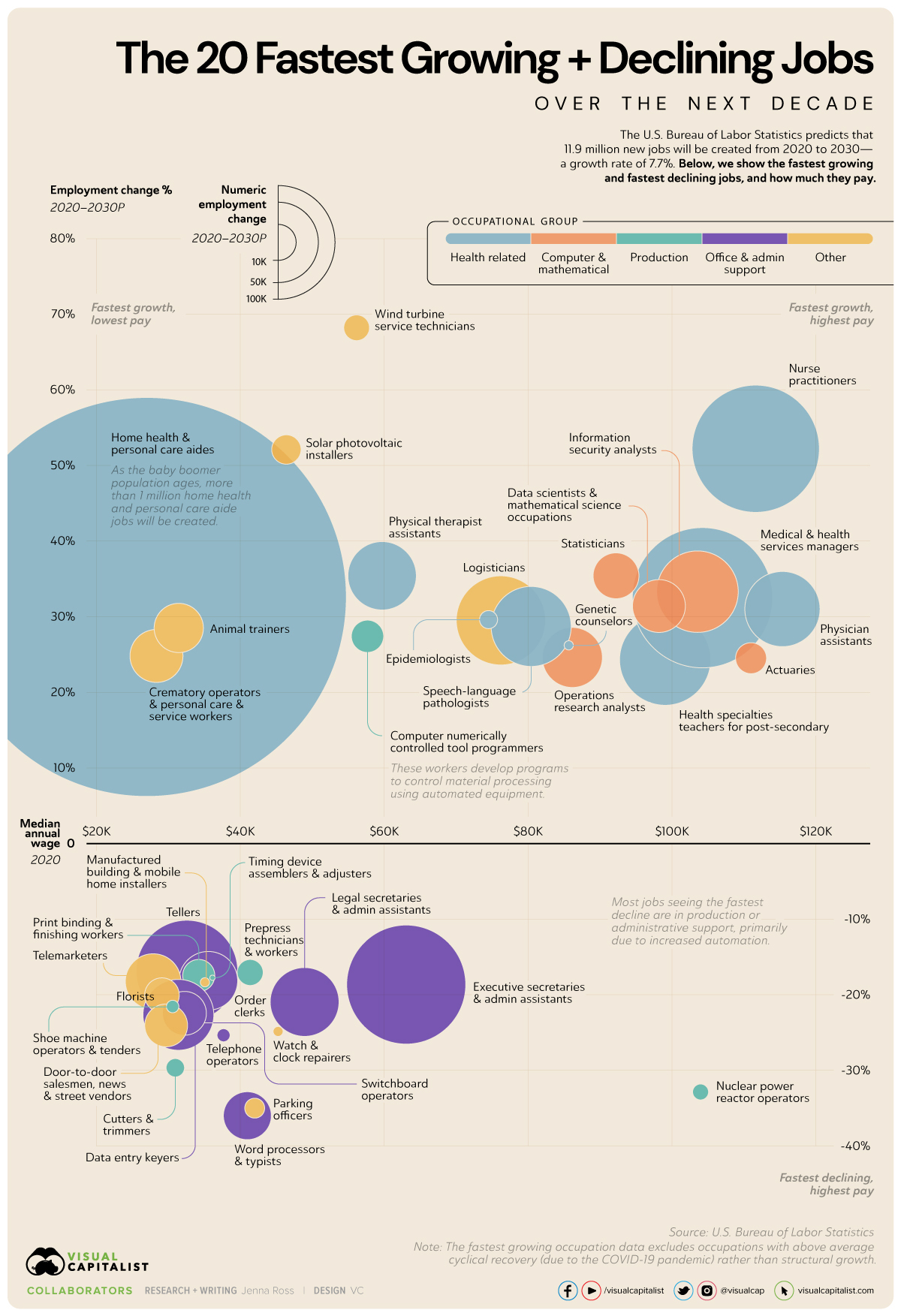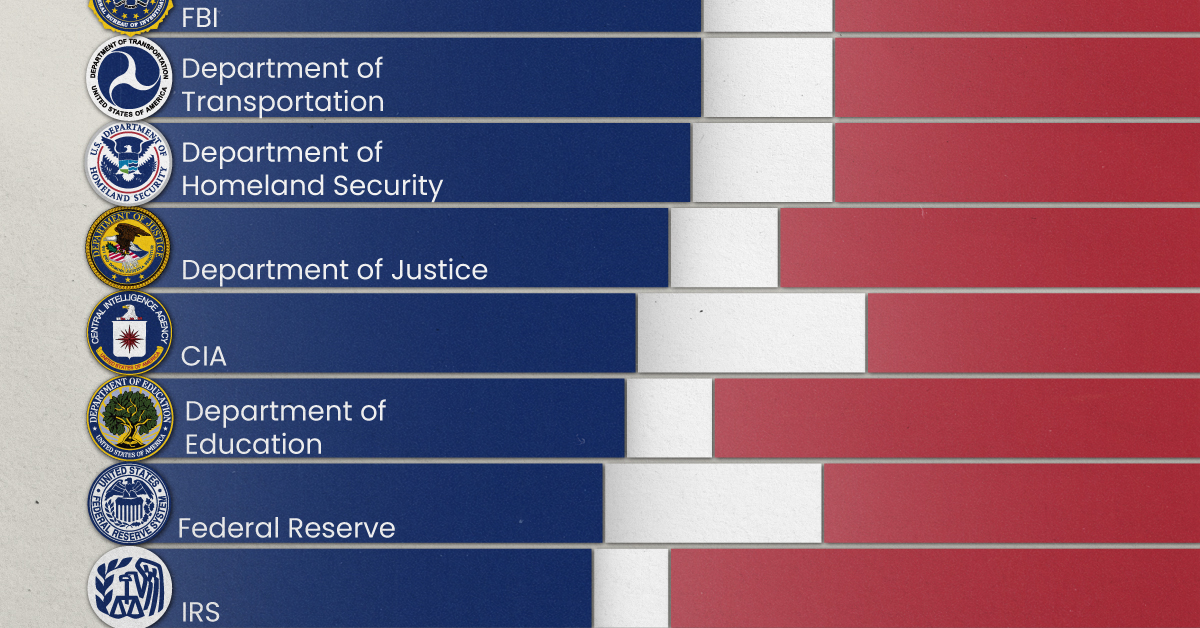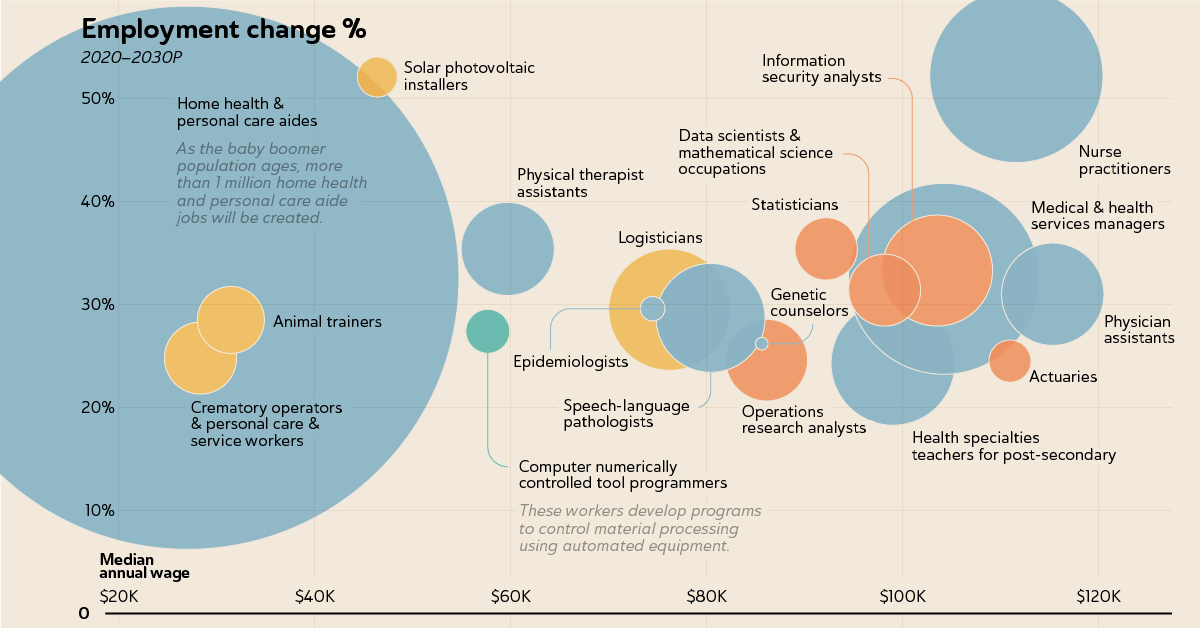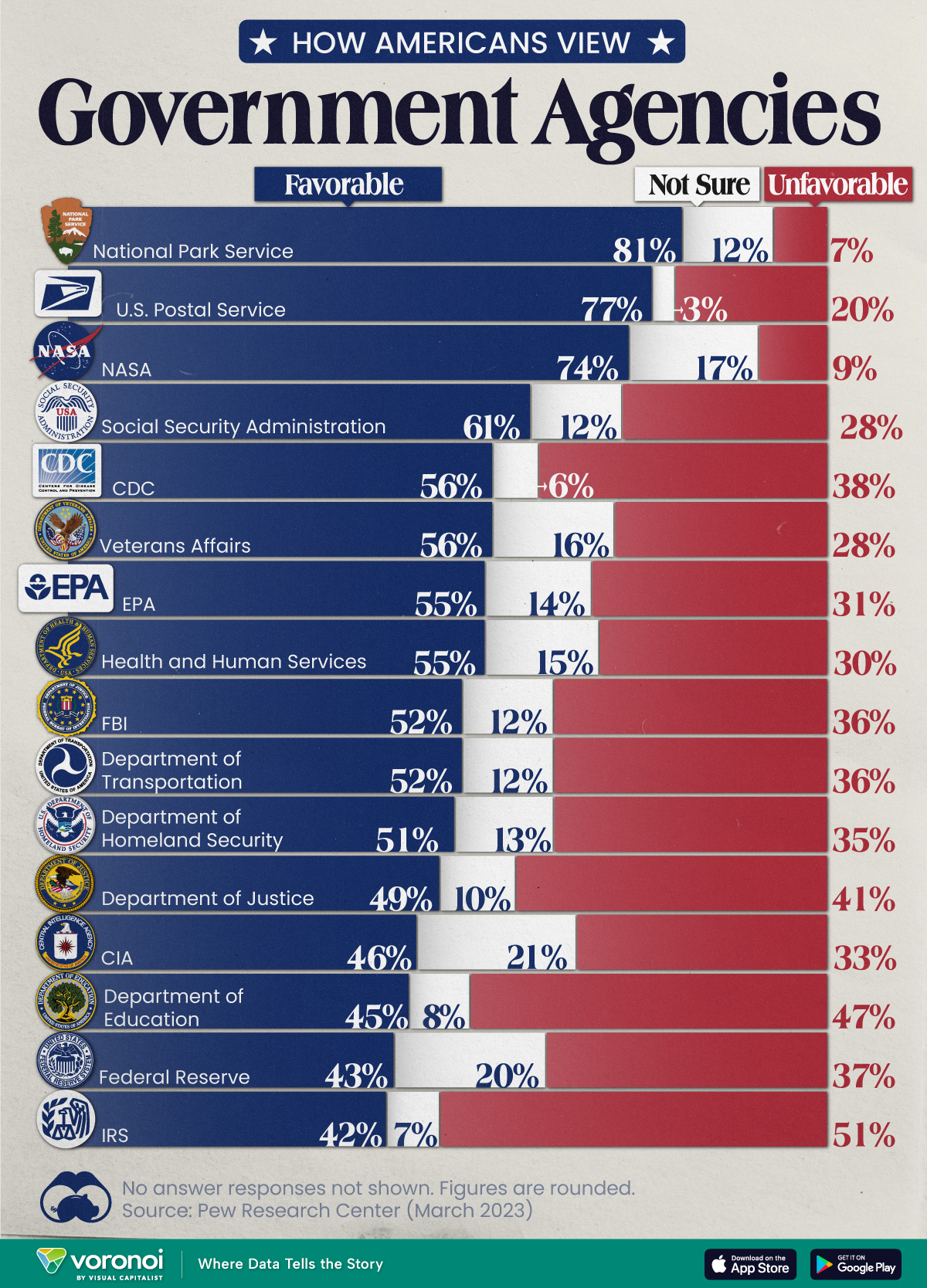Economy
The 20 Fastest Growing Jobs in the Next Decade

How is the Job Market Shifting Over the Next Decade?
The employment landscape is constantly shifting. While agricultural jobs played a big role in the 19th century, a large portion of U.S. jobs today are in administration, sales, or transportation. So how can job seekers identify the fastest growing jobs of the future?
The U.S. Bureau of Labor Statistics (BLS) projects there will be 11.9 million new jobs created from 2020 to 2030, an overall growth rate of 7.7%. However, some jobs have a growth rate that far exceeds this level. In this graphic, we use BLS data to show the fastest growing jobs—and fastest declining jobs—and how much they each pay.
The Top 20 Fastest Growing Jobs
We used the dataset that excludes occupations with above average cyclical recovery from the COVID-19 pandemic. For example, jobs such as motion picture projectionists, ticket takers, and restaurant cooks were removed. Once these exclusions were made, the resulting list reflects long-term structural growth.
Here are the fastest growing jobs from 2020 to 2030, along with the number of jobs that will be created and the median pay for the position.
| Occupation | Percent employment change, 2020–2030P | Numeric employment change, 2020-2030P | Median annual wage, 2020 |
|---|---|---|---|
| Wind turbine service technicians | 68.2% | 4,700 | $56,230 |
| Nurse practitioners | 52.2% | 114,900 | $111,680 |
| Solar photovoltaic installers | 52.1% | 6,100 | $46,470 |
| Statisticians | 35.4% | 14,900 | $92,270 |
| Physical therapist assistants | 35.4% | 33,200 | $59,770 |
| Information security analysts | 33.3% | 47,100 | $103,590 |
| Home health and personal care aides | 32.6% | 1,129,900 | $27,080 |
| Medical and health services managers | 32.5% | 139,600 | $104,280 |
| Data scientists and mathematical science occupations, all other | 31.4% | 19,800 | $98,230 |
| Physician assistants | 31.0% | 40,100 | $115,390 |
| Epidemiologists | 29.6% | 2,300 | $74,560 |
| Logisticians | 29.5% | 56,400 | $76,270 |
| Speech-language pathologists | 28.7% | 45,400 | $80,480 |
| Animal trainers | 28.5% | 17,200 | $31,520 |
| Computer numerically controlled tool programmers | 27.4% | 7,400 | $57,740 |
| Genetic counselors | 26.2% | 600 | $85,700 |
| Crematory operators and personal care and service workers, all other | 24.8% | 19,900 | $28,420 |
| Operations research analysts | 24.6% | 25,600 | $86,200 |
| Actuaries | 24.5% | 6,800 | $111,030 |
| Health specialties teachers, post-secondary | 24.3% | 58,900 | $99,090 |
Wind turbine service technicians have the fastest growth rate, with solar photovoltaic (solar panel) installers taking the third slot. The rapid growth is driven by demand for renewable energy. However, because these are relatively small occupations, the two roles will account for about 11,000 new jobs collectively.
Nine of the top 20 fastest growing jobs are in healthcare or related fields, as the baby boomer population ages and chronic conditions are on the rise. Home health and personal care aides, who assist with routine healthcare tasks such as bathing and feeding, will account for over one million new jobs in the next decade. This will be almost 10% of all new jobs created between 2020 and 2030. Unfortunately, these workers are the lowest paid on the list.
Computer and math-related jobs are also expected to see high growth. The BLS expects strong demand for IT security and software development, partly because of the increase in people that are working from home.
The Top 20 Fastest Declining Jobs
Structural changes in the economy will cause some jobs to decline quite quickly. Here are the top 20 jobs where employment is expected to decline the fastest over the next decade.
| Occupation | Percent employment change, 2020–2030P | Numeric employment change, 2020-2030P | Median annual wage, 2020 |
|---|---|---|---|
| Word processors and typists | -36.0% | -16,300 | $41,050 |
| Parking enforcement workers | -35.0% | -2,800 | $42,070 |
| Nuclear power reactor operators | -32.9% | -1,800 | $104,040 |
| Cutters and trimmers, hand | -29.7% | -2,400 | $31,630 |
| Telephone operators | -25.4% | -1,200 | $37,710 |
| Watch and clock repairers | -24.9% | -700 | $45,290 |
| Door-to-door sales workers, news and street vendors, and related workers | -24.1% | -13,000 | $29,730 |
| Switchboard operators, including answering service | -22.7% | -13,600 | $31,430 |
| Data entry keyers | -22.5% | -35,600 | $34,440 |
| Shoe machine operators and tenders | -21.6% | -1,100 | $30,630 |
| Legal secretaries and administrative assistants | -21.0% | -33,600 | $48,980 |
| Floral designers | -20.1% | -8,500 | $29,140 |
| Executive secretaries and executive administrative assistants | -18.7% | -100,600 | $63,110 |
| Manufactured building and mobile home installers | -18.4% | -600 | $35,120 |
| Telemarketers | -18.3% | -21,900 | $27,920 |
| Order clerks | -18.2% | -24,400 | $35,590 |
| Timing device assemblers and adjusters | -17.8% | -200 | $36,170 |
| Print binding and finishing workers | -17.5% | -7,300 | $34,260 |
| Prepress technicians and workers | -17.1% | -4,800 | $41,410 |
| Tellers | -16.9% | -73,100 | $32,620 |
Eight of the top 20 declining jobs are in office and administrative support. This could be cause for concern, given this category currently makes up almost 13% of employment in the U.S.—the largest of any major category. Jobs involved in the production of goods and services, as well as sales jobs, are also seeing declines.
In all cases, automation is likely the biggest culprit. For example, software that automatically converts audio to text will reduce the need for typists.
While the fastest declining jobs typically fall within the lower salary range, there is one outlier. Nuclear power reactor operators, who earn a salary of over $100,000, will see employment decline at a steep rate of -33%. No new nuclear plants have opened since the 1990s, and nuclear power faces steep competition from renewable energy sources.
Warning: Education Required
As the composition of employment shifts, it eliminates some jobs and creates others. For instance, while production jobs are declining, new opportunities exist for “computer numerically controlled tool programmers.” These workers develop programs to control the automated equipment that processes materials.
However, while many of the fastest growing jobs are higher paying, they typically also require advanced education.
| Top 20 Fastest Growing Jobs | Top 20 Fastest Declining Jobs | |
|---|---|---|
| # with median salary > $41,950 | 17 | 5 |
| # with post-secondary education required | 16 | 0 |
Seventeen of the top 20 fastest growing jobs have a median salary higher than $41,950, which is the median salary for all jobs in total. Most also require post-secondary schooling. These opportunities are replacing jobs that only required a high school diploma.
With tuition costs soaring relative to inflation, this could create challenges for displaced workers or young people entering the workforce.
Public Opinion
Charted: How Americans Feel About Federal Government Agencies
Fourteen of 16 federal government agencies garnered more favorable responses than unfavorable ones. But what were the outliers?

Chart: How Americans Rate 16 Federal Government Agencies
This was originally posted on our Voronoi app. Download the app for free on iOS or Android and discover incredible data-driven charts from a variety of trusted sources.
Come election time, America won’t hesitate to show its approval or disapproval of the country’s elected political representatives. That said, feelings about the federal bureaucracy and its associated agencies are a little harder to gauge.
We chart the results from an opinion poll conducted by Pew Research Center between March 13-19, 2023. In it, 10,701 adults—a representative of the U.S. adult population—were asked whether they felt favorably or unfavorably towards 16 different federal government agencies.
Americans Love the Park Service, Are Divided Over the IRS
Broadly speaking, 14 of the 16 federal government agencies garnered more favorable responses than unfavorable ones.
Of them, the Parks Service, Postal Service, and NASA all had the approval of more than 70% of the respondents.
| Agency | Favorable | Unfavorable | Not sure |
|---|---|---|---|
| 🏞️ National Park Service | 81% | 7% | 12% |
| 📮 U.S. Postal Service | 77% | 20% | 3% |
| 🚀 NASA | 74% | 9% | 17% |
| 💼 Social Security Administration | 61% | 28% | 12% |
| 🔬 CDC | 56% | 38% | 6% |
| 🎖️ Veterans Affairs | 56% | 28% | 16% |
| 🌿 EPA | 55% | 31% | 14% |
| 💉 Health & Human Services | 55% | 30% | 15% |
| 🕵️ FBI | 52% | 36% | 12% |
| 🚗 Department of Transportation | 52% | 36% | 12% |
| 🛡️ Department of Homeland Security | 51% | 35% | 13% |
| ⚖️ Department of Justice | 49% | 41% | 10% |
| 🕵️♂️ CIA | 46% | 33% | 21% |
| 📚 Department of Education | 45% | 47% | 8% |
| 💰 Federal Reserve | 43% | 37% | 20% |
| 💼 IRS | 42% | 51% | 7% |
Note: Figures are rounded. No answer responses are not shown.
Only the Department of Education and the IRS earned more unfavorable responses, and between them, only the IRS had a majority (51%) of unfavorable responses.
There are some caveats to remember with this data. Firstly, tax collection is a less-friendly activity than say, maintaining picturesque parks. Secondly, the survey was conducted a month before taxes were typically due, a peak time for experiencing filing woes.
Nevertheless, the IRS has come under fire in recent years. As per a New York Times article in 2019, eight years of budget cuts have stymied the agency’s ability to scrutinize tax filings from wealthier and more sophisticated filers.
At the same time poorer Americans are facing increasing audits on wage subsidies available to low income workers. According to a Transactional Records Access Clearinghouse report, this subset of filers was audited five-and-a-half more times the average American.
-

 Technology5 days ago
Technology5 days agoMapped: The Number of AI Startups By Country
-

 Jobs2 weeks ago
Jobs2 weeks agoThe Best U.S. Companies to Work for According to LinkedIn
-

 Economy2 weeks ago
Economy2 weeks agoRanked: The Top 20 Countries in Debt to China
-

 Politics2 weeks ago
Politics2 weeks agoCharted: Trust in Government Institutions by G7 Countries
-

 Energy2 weeks ago
Energy2 weeks agoMapped: The Age of Energy Projects in Interconnection Queues, by State
-

 Mining2 weeks ago
Mining2 weeks agoVisualizing Global Gold Production in 2023
-

 Markets1 week ago
Markets1 week agoVisualized: Interest Rate Forecasts for Advanced Economies
-

 Economy1 week ago
Economy1 week agoThe Most Valuable Companies in Major EU Economies














